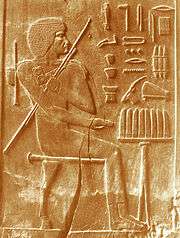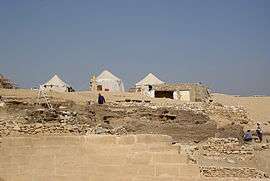Hesy-Ra
Hesy-Ra (also read Hesy-Re and Hesire) was an ancient Egyptian high official during the early Third Dynasty of Egypt. His most notable title was Wer-ibeh-senjw, meaning either "Great one of the ivory cutters" or "Great one of the dentists", which would make him the earliest dentist whose name is known to us. His tomb is noted for its paintings and cedar wood panels.
| Hesy-Ra in hieroglyphs | |||||
|---|---|---|---|---|---|
| Personal name: Hesy-Re rʳ-ḥsj Blessed by Ra | |||||
| Nickname: Hesy ḥsj Blessed | |||||
| Honorary title: Rekh-neswt rḫ-nsw.t Confidant of the king | |||||
 | |||||
Identity
Thanks to several clay seal impressions found in Hesy-Ra's tomb, it is today known that this high official lived and worked during the reign of king (pharaoh) Djoser and maybe also under king Sekhemkhet.[1]
Hesy-Ra's name is of some interest to Egyptologists and historians alike, because it is linked to the sun god Re. Hesy-Ra, alongside a few high officials at this time, belongs to the first high officials who were allowed to link their names to Re. However, they were not allowed to use the sun disk hieroglyph to write Re's name. This was permitted to the king only.[1][2]
Titles
As a high-ranking official and priest, Hesy-Ra bore several elite and pious titularies:[3][4]
- Confidant of the king (Egyptian: Rekh-neswt).
- Great one of the "ten of Upper Egypt" (Egyptian: Wer-medi-shemaw).
- Great one of Peh (Egyptian: Wer-Peh).
- Great one of the dentists (Egyptian: Wer-ibeh-senjw).
- Elder of the "Qed-hetep" (Egyptian: Semsw-qed-hetep).
- Chief of the scribes (Egyptian: Medjeh-seschjw).
- Brother of Min (Egyptian: Sen-Min).
- Magician of Mehit (Egyptian: Hem-heka-Mehit).
Career
Hesy-Ra is well known for certain, unique titles. The most discussed title is Wer-ibeh-senjw, which can be translated in many ways. Ibeh can be translated as "dentition" and/or "ivory" as well. Senjw is a plural for "arrows", "cutters" and/or "physicians" alike. Thus, the full title Wer-ibeh-senjw can either be translated as "Great one of the ivory cutters" or as "Great one of the dentists". If the former translation was correct, Hesy-Ra was a professional ivory-cutter and artist - a profession that was fairly common and already attested in early dynastic inscriptions. If the latter translation was correct, Hesy-Ra would be the very first person in Egyptian history to be officially entitled as an occupational dentist.[3]
Hesy-Ra is also well known for his richly decorated cedar wood panels found in his tomb. On these panels, Hesy-Ra is depicted in several stages of age. Indeed, the panels close to the entrance show Hesy-Ra as a pretty young man at the start of his career. Closer to the remembrance chapel, Hesy-Ra is depicted as a middle-aged man at the heyday of his career. Finally, in the remembrance chapel, he is depicted as an old man, sitting on an offering table and being stuffed in a tight gown. The artist of the panels even accentuated facial mannerisms of age: Hesy-Ra's face changes from pretty smooth to wrinkled and saggy, depending on the stage of age that was meant to be depicted.[5][6]
 The portraits of Hesy-Ra
The portraits of Hesy-Ra from different
from different stages of age
stages of age
Furthermore, Hesy-Ra is known for the colorful wall paintings discovered inside and outside his tomb. Colors such as black, white, yellow, green and red were used. The ornaments include rhomboids, stripes and a green-yellowish reed mat imitation. The paintings were in such a good state when found, that the excavators decided to fill the painted corridors with high quality rubble in attempt to preserve the colors. Close-by reliefs depict daily life goods and even game accessories, such as Mehen game boards and a Senet play set.[5][6]
Possible contemporary office partners included Netjeraperef, Akhetaa,[7] Khabawsokar, Pehernefer and Metjen,[8] who were also holding office under Huni and Sneferu. All their tomb inscriptions reveal that the time of both kings must have been a very prosperous one and economy and office administration flourished.[9]
Tomb

Hesy-Ra's tomb, mastaba S-2405, is situated in Saqqara; it was discovered in 1861 by French archaeologists Auguste Mariette and Jacques de Morgan. Excavations started in 1910 and ended in 1912, organized and performed by British archaeologist James Edward Quibell. Hesy-Ra's tomb is squeezed in between dozens of others, approximately 260 m north-east of king Djoser's pyramid complex. In its original state, the mastaba was 43 m long, 22 m wide and 5 m high. It was made of hardened mud bricks. Inner and outer walls were once completely and smoothly covered with white limestone. The inner room structure consisted of a long, niched corridor and several rooms and chapels.[10][11]
See also
References
| Wikimedia Commons has media related to Hesy-Ra. |
| Wikimedia Commons has media related to Mastaba of Hesy-Ra. |
- Wolfgang Helck: Geschichte des alten Ägypten (= Handbuch der Orientalistik. Abt. 1: Der Nahe und der Mittlere Osten. Bd. 1: Ägyptologie; Abschnitt 3). BRILL, Leiden 1968, page 47.
- Hermann Ranke: Die ägyptischen Personennamen. Augustin, Glückstadt 1935–1977, page 254, No. 29 & page 255, No. 3.
- John F. Nunn: Ancient Egyptian Medicine. Oklahoma Press, Norman 2002, ISBN 0-8061-3504-2, page 124.
- Dilwyn Jones: An Index of ancient Egyptian titles, epithets and phrases of the Old Kingdom, Volume 1 (= BAR international Series, vol. 866, section 1). Archaeopress, Oxford 2000, ISBN 1-8417-1069-5, page 381, no. 1412.
- Henriette Antonia Groenewegen-Frankfort: Arrest and movement. An essay on space and time in the representational art of the ancient Near East. Harvard University Press, Cambridge (Massachusetts) 1987, ISBN 0-674-04656-0, p. 29–31.
- Whitney Davis: Archaism and Modernism in the Reliefs of Hesy-Ra. In: John Tait: Never had the like occurred. Egypt's View of Its Past (= Encounters with ancient Egypt). UCL Press, London 2003, ISBN 1-84472-007-1, p. 31–60.
- Harco Willems: Historical and Archaeological Aspects of Egyptian Funerary Culture: Religious Ideas and Ritual Practice in Middle Kingdom Elite Cemeteries. BRILL, Leiden 2014, ISBN 9004274995, p. 22-23.
- Hratch Papazian: Departments, Treasuries, Granaries and Work Centers. In: Juan Carlos Moreno García: Ancient Egyptian Administration. Brill, Leiden 2013, ISBN 9004250085, p. 73-74.
- Toby A. H. Wilkinson: Early Dynastic Egypt. Routledge, London 2002, ISBN 0203024389, p. 119.
- Emad El-Metwally: Entwicklung der Grabdekoration in den altägyptischen Privatgräbern. Ikonographische Analyse der Totenkultdarstellungen von der Vorgeschichte bis zum Ende der 4. Dynastie (= Göttinger Orientforschungen, Reihe 4: Ägypten; Volume 24). Harrassowitz, Wiesbaden 1992, ISBN 3-447-03270-7, p. 21-23 & 81.
- William Stevenson Smith, William Kelly Simpson: The art and architecture of Ancient Egypt. Yale University Press, New Haven 1998 (3rd edition), ISBN 0-300-07747-5, p. 33.